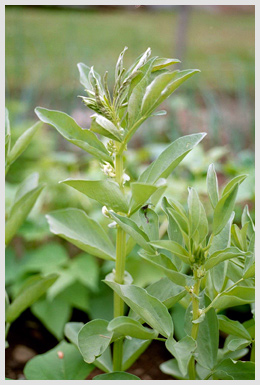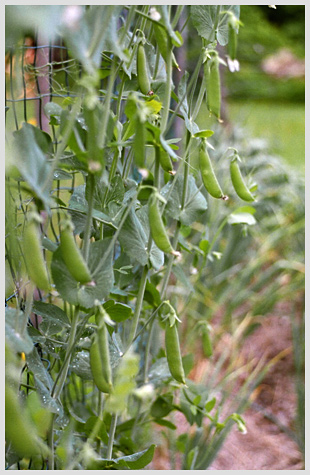
Able to take the chill, and really good for you,
spinach is a wonderful choice for the early garden.
Photo: Lynette L. Walther
Springtime in Maine can be frustrating for gardeners. Too much rain, not enough rain, too much cold or not enough—you name it, Maine can deliver it—a mixed bag of weather is the norm for this time of year. But there’s one thing for sure, if you want to grow vegetables, you will need plenty of sun. That’s the one thing that’s missing from our cozy-but-shady in-town home. Thanks to a generous friend who has a large and sunny piece of property I have been able to share a garden plot with her for several years running. In addition to the dirt and sun, we share garden tasks: cultivating, planting, weeding, watering, and picking. The arrangement has worked well, and both her family and mine benefit from a varied harvest of fresh vegetables and a few berries.
This is always a busy time of year for us, getting the soil “fluffed” as I call it, deciding what and how we’ll portion out the garden space which seems to get smaller every year as we expand our horizons of produce preferences. There’s always some new tomato or lettuce variety to try. Should we try winter squash again after last year’s invasion of squash bugs? Should we give any space to onions? How many hills of pumpkins? Should there be a hill of zucchini or summer squash? Do we grow bush or pole beans, or both?
Even though we seem to leave more than enough room between rows and hills and other plantings, by August it is almost impossible to get in the garden to pick anything. Plus we usually don’t know until then if we are going to get any vine-ripened tomatoes, which, if the truth were to be told, is the real reason we are gardening at all….
Even when the groundhogs, deer, and other critters leave our crops alone, it is the weather that determines what our little vegetable patch will produce, not our skill or dedication to garden chores. This time of year it is our eagerness to get stuff into the ground that sometimes means we have to re-plant certain crops such as bush or pole beans.

Fava beans thrive on cooler temperatures, making them
a sure bet for early gardens. Their striking
black and white flowers make them nice
additions to flower beds as well.
Photo: Lynette L. Walther
It doesn’t take a great dip in temperature to stop bush beans cold in their tracks. They need night-time temperatures of 60 degrees or above to set blooms, something you are not going to get during a Maine spring.
But not all bush beans are that tender. Take fava beans for instance. They like it cold. These tough plants are just the ticket for early gardens here.
The small bean pods can be cooked, sliced and eaten like snap beans. Foliage tips can be pinched, and are one of the spring’s tastiest greens. But those willing to wait a bit are rewarded with the shelled fava beans, tender and meaty-flavored to eat solo or added to soups and stews. Favas take 85 days from planting to maturity.
If that isn’t enough, the plants themselves are attractive with their bluish-green foliage and pretty black and white flowers. I’d even suggest using favas in flowerbeds.
Though technically a bush bean, some staking might be necessary as these plants grow to about two feet tall. When it comes to growing conditions, think of them as you would peas. They can take some pretty chilly temperatures.
When it comes to peas, snow peas are one of our favorites. Oregon Sugar Pod II snow peas are exceptional in their cold and heat resistance. Also disease resistant, these champs continue to produce big stringless (yes, a stringless snow pea) pods well after the temperatures begin to climb back up again.

It only takes one row of Oregon Sugar Pod snow peas
to produce plenty of sweet and tender peas. Try the peas in
a stir-fry. Or, sauté them with wild mushrooms and
early season corn kernels cut from the cob. Add some
grated Romano cheese for a pasta dish with flair.
Photo: Lynette L. Walther
If you grow only one snow pea, make it this one. Just one row of snow peas produces a big harvest spread out over several weeks. A true climber, this variety produces somewhat shorter vines, about 28 inches tall that are easier to manage.
When planting snow peas, be sure to have netting or a trellis already in place so that the tiny plants aren’t disturbed once they start to climb.
Another early performer is Bloomsdale spinach. A good source of iron, and vitamins A and C, spinach is low in calories and high in fiber. Successive plantings, about a week apart, help spread out the harvest of tender, small leaves.
For the earliest lettuce, plant a shallow saucer or tray with a selection of lettuce seeds (
click here for an article on starting seedlings & soil). When plants are about three inches tall, separate and transplant them into garden rows. Water well and watch them grow! This method produces leafy, compact heads more quickly than does in-ground sowing of seeds.
While it may not be time to set out the tomato plants (there are bound to be more than a few more cold nights) there are plenty of choices here for vegetable gardeners to get going.
Click here for an article on starting seedlings & soil by Lynette L. Walther
Contributing Garden Editor Lynette L. Walther is the recipient of the National Garden Bureau’s Exemplary Journalism Award and the IABC Silver Quill Award of Excellence. She is a member of the Garden Writers Association. She gardens in Camden. Click here to view all of Lynette L. Walther's articles.
 Able to take the chill, and really good for you,
Able to take the chill, and really good for you,  Fava beans thrive on cooler temperatures, making them
Fava beans thrive on cooler temperatures, making them  It only takes one row of Oregon Sugar Pod snow peas
It only takes one row of Oregon Sugar Pod snow peas 






